|
A Fantasmagorical Vision...
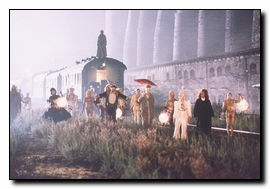 "Alegria", which takes its title from a Spanish word meaning elation,
joy, and jubilation, is the first feature film inspired by Cirque du Soleil.
"Alegria", the film, is inspired by Cirque du Soleil’s tenth anniversary
production of the same name, but it is far more than a mere documentation
of the live event. Instead, the cinematic medium is employed to expand and
transform the original, fantasmagorical vision; audiences who thrilled to
the stage version will find this "Alegria" a delightfully new and different
experience. The original is finally only a stepping-off point for the film,
which moves Cirque du Soleil’s dreamlike imagery out of the Big Top and into
the real world, and, more importantly, introduces a narrative love story
enacted by a distinguished international cast.
"Alegria", which takes its title from a Spanish word meaning elation,
joy, and jubilation, is the first feature film inspired by Cirque du Soleil.
"Alegria", the film, is inspired by Cirque du Soleil’s tenth anniversary
production of the same name, but it is far more than a mere documentation
of the live event. Instead, the cinematic medium is employed to expand and
transform the original, fantasmagorical vision; audiences who thrilled to
the stage version will find this "Alegria" a delightfully new and different
experience. The original is finally only a stepping-off point for the film,
which moves Cirque du Soleil’s dreamlike imagery out of the Big Top and into
the real world, and, more importantly, introduces a narrative love story
enacted by a distinguished international cast.
Dragone wanted to create a parable of the ongoing plight of the 250 million
children around the world who are forced to work under terrible conditions, a
theme made concrete in the child-character Momo, who helps lead a fantastic
rebellion against the evil flower vendor, Marcello. "I don’t only want to shoot
a film. I want to touch people," he says.
""Alegria" is a rallying cry for people who are losing their confidence and
feeling increasingly alone in the world. We’re trying to tell a fable with heart
and courage," says Rudy Barichello, Producer and Co-Writer.
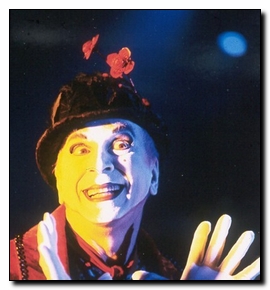 The combination of imagery, emotion and social purpose made it relatively
easy to attract talent and financing. As producer Stephane Reichel comments,
"the project reminds me of why I fell in love with this industry in the first
place."
The combination of imagery, emotion and social purpose made it relatively
easy to attract talent and financing. As producer Stephane Reichel comments,
"the project reminds me of why I fell in love with this industry in the first
place."
Executive Producer Hélène Dufresne and Producer Rudy Barichello assembled the
financing for the Canada/France/Holland co-production between Montreal’s Lampo Di
Vita Films Inc.; Paris-based Mainstream, and Amsterdam’s Egmond (Film/Television
BV), produced with the participation of Canada Television and Cable Production Fund/
Telefilm Canada/Equity Investment Program.
Dragone and Barichello specifically wrote the part of the disillusioned mime,
Frac, for René Bazinet, an internationally renowned mime and clown who toured for
four years with Cirque du Soleil’s Saltimbanco. "The role was tailor-made for me,"
smiles Bazinet, who makes his feature film debut in a lead role.
"I was a street actor in Paris for nine years." The role is, in many ways, an
homage to one of Bazinet’s favorite films, Marcel Carmé’s legendary "Les Enfants du
Paradis" ("Children of Paradise," 1945), which Bazinet has seen 19 times. In Carmé’s
film, the great French mime Jean-Louis Barrault plays a Parisian pantomime who falls
in love with an elusive woman, a theme poetically echoed in "Alegria".
When Dragone first saw English actress Julie Cox at a London audition, he knew
instantly he had found his Giulietta. "Julie has a vulnerability and a transcendent
beauty," says Dragone, who likens Cox to Julietta Masina, the legendary actress/wife
of Federico Fellini.
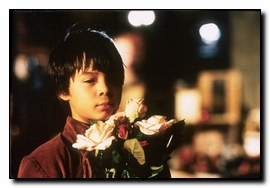 Cox was immediately taken by the script. "It was the first script I’d read for
a long time that had a unique voice and was so creatively satisfying. The character,
Giulietta, has led a protected life growing up in the circus. Her closest friends are
her family. It is only when she meets Frac that her curiosity about the outside world
is fueled." Cox notes that "Alegria" is really two, overlapping stories. "One is a
story between two people who fall in love, and the other is the story of Frac’s world
and the children."
Cox was immediately taken by the script. "It was the first script I’d read for
a long time that had a unique voice and was so creatively satisfying. The character,
Giulietta, has led a protected life growing up in the circus. Her closest friends are
her family. It is only when she meets Frac that her curiosity about the outside world
is fueled." Cox notes that "Alegria" is really two, overlapping stories. "One is a
story between two people who fall in love, and the other is the story of Frac’s world
and the children."
In the role of Giulietta’s father, Fleur, Frank Langella creates a multileveled
characterization in a multi-layered story. Since Langella is equally comfortable working
on stage or on screen, the fusion of live performance and cinema in "Alegria" made for
an especially interesting assignment. According to Langella, the character of Fleur
also straddles two worlds. "He’s a man with two sides, the one he presents onstage to
the world—a fool who winks at the audience—and the other, the worried father concerned
for his daughter."
After meeting with Langella in New York, Dragone remarked, "Frank is Fleur. He has
a kind of serenity I haven’t found in anyone else." British actor/playwright/author
Heathcote Williams leapt at the chance to play the villainous Marcello. "He’s a
contrapuntal character," says Williams, "representing the lowest common denominator
in consumer capitalism. He represents what’s wrong with the world in microcosm—each
one of the seven deadly sins. You get seven for the price of one," he laughs. The
casting of nine-year-old Clipper Miano as the street urchin, Momo, Frac’s sidekick,
was the culmination of an extensive search in Europe and North America. Miano had
recently co-starred in the film "Smilla’s Sense of Snow," and proved a natural for
a key role in "Alegria".
Beyond the principal cast, 50 Cirque du Soleil artists reprise their roles from
the stage version of Alegría. Among these are three outstanding clowns, all originally
from Russia—Yuri, Dima, and Sergei, the only deaf-and-proud-of-it performer in Cirque.
(Actress Julie Cox learned sign language to communicate with him for scenes in the film.)
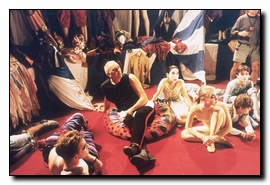 "Alegria" was shot in Amsterdam (where Cirque du Soleil’s European head office
is based) and Berlin (where the stage version of Alegría was playing under the Big
Top) between July 10 and September 6, 1997. Production Designer Ben van Os was eager
for the film to have a visual style distinct from the stage version, while retaining
an ethereal, fairy-tale quality. In Amsterdam, he found two existing locations in
which to build his fantastic environments: the 100-year-old former Western Gas
Factory building, and the 1928 Olympic Stadium.
"Alegria" was shot in Amsterdam (where Cirque du Soleil’s European head office
is based) and Berlin (where the stage version of Alegría was playing under the Big
Top) between July 10 and September 6, 1997. Production Designer Ben van Os was eager
for the film to have a visual style distinct from the stage version, while retaining
an ethereal, fairy-tale quality. In Amsterdam, he found two existing locations in
which to build his fantastic environments: the 100-year-old former Western Gas
Factory building, and the 1928 Olympic Stadium.
The gas factory’s main space was a gigantic steel cylinder, 55 meters wide and
20 meters high. Here, van Os created Marcello’s flower factory, an environment both
sinister and enchanting. Using five kilometers of rope, the designer framed Marcello’s
central raised podium in the manner of a giant spider’s web, from which the villain
oversees his young workers. Ten thousand flowers, half fresh and half artificial,
planted in straw and sand and suspended from the ceiling in over 1,200 hanging bottles,
filled the air with color and perfume. The children’s beds were also surrealistically
suspended from the rafters, like gravity-defying pup tents.
Over 24,000 kilos of colorful, recycled garments were utilized for the scene in
which Frac, Giulietta and Momo rescue the children from Marcello’s factory and buy
them new clothes. In another building at the gas factory, van Os constructed a 60-foot
wide ramp angled at 30 degrees against the wall, and smothered it with a veritable
avalanche of clothing, in which the children happily romped, exchanging their drab
factory garb for new Sunday whites.
To create the "Cauldron," the urban center populated by lost souls, where Frac
makes his home, van Os constructed an entire street, utilizing the exterior walls
of the Olympic Stadium. The set included a restaurant called the Café Opera, as well
as a red light district. The original concept called for a highly realistic set, but,
as Costume Designer Dominique Lemieux notes, the design evolved into a "twisted
realism," blending fantastic costumes and wide-angled photography.
Lemieux, who has worked with Dragone on every Cirque du Soleil production since
1990, created more than 2,000 costumes for "Alegria". In order to differentiate
different groups in the crowd scenes, she employed a deliberate system of color-coding.
"For example, normal people are dressed in blue, the merchants in voluminous outfits
in earth colors, and the prostitutes in pastels—soft colors versus hard."
The habitués of the Café Opera, representing the dark heart of the Cauldron, were
differentiated from the street denizens by color as well as fabric; instead of the
cottons and transparent silks worn by the Merchants and prostitutes, the Café patrons
were dressed by Lemieux in heavy velvets and dark tones—blacks, dark greens, and violets.
Lemieux had more challenges when the production moved from Amsterdam to Berlin and
she was faced with dressing at least 2,500 of the 3,000 extras employed. "Thank goodness
I’d already designed 50 costumes for the original production," Lemieux laughs. In
particular, the scene in which 1,000 clamoring children dressed entirely in white fill
the tent in tribute to Giulietta’s return to the circus, created occasionally overwhelming
logistics of movement and crowd control. The production shot for three weeks in Berlin,
photographing around the regular stage performances, which closed for one week to allow
Dragone to create a world of total movie magic on the original theatrical sets.
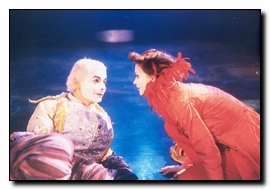 The bold stage costumes emerge as impressive on screen as they were under the Big Top,
in predominant colors of white, gold, silver, and bronze. To differentiate Giulietta’s
character, Lemieux chose red. "Because she’s full of vitality, red—which I didn’t use
in the stage version—is a very good color for her." Fleur’s master-of-ceremonies costume
echoes his daughter’s predominant, emotional hue. For Frac, Lemieux created a classic
mime icon, whose costumes, like that of most of the characters, are loose-fitted and
fluid, allowing a maximum of expressive movement. Additionally, all costume colors had
to be carefully selected to compensate for variable light levels—more than half the
film was shot at night.
The bold stage costumes emerge as impressive on screen as they were under the Big Top,
in predominant colors of white, gold, silver, and bronze. To differentiate Giulietta’s
character, Lemieux chose red. "Because she’s full of vitality, red—which I didn’t use
in the stage version—is a very good color for her." Fleur’s master-of-ceremonies costume
echoes his daughter’s predominant, emotional hue. For Frac, Lemieux created a classic
mime icon, whose costumes, like that of most of the characters, are loose-fitted and
fluid, allowing a maximum of expressive movement. Additionally, all costume colors had
to be carefully selected to compensate for variable light levels—more than half the
film was shot at night.
Giulietta’s most elegant costume is without question the "Overture" ensemble, its
brilliant red-feather raised collar reflecting a bird motif that recurs throughout the
film, from the commedia-inspired "Old Bird" characters of the Cirque to a passel of cooing
doves which join René Bazinet as he reclines in a tree shot on location in Amsterdam’s
museum square. To express a sense of freedom, more than a dozen homing pigeons were
released for the scene—and promptly headed home to a village on the Holland-Belgium border,
some 200 kilometers away. Even a waddling gaggle of geese put in an appearance, during
an early scene in the "Cauldron."
In Berlin, the overall production design was enhanced by a wealth of evocative
historical locations. The Fairy Tale Fountain, an Italian fantasy built in the early
1900s as an homage to the Brothers Grimm, provided a extraordinary backdrop for the
sylph-like performer Elena Lev to twirl sparking silver hoops while ankle deep in
cascading water. Cirque performers mirrored the stepped fountain’s imaginative statuary,
posing in the arches while filmed through a romantic mist. The landmark, St. Elisabeth
Church, built in the 1830s and heavily damaged by World War II bombing, was utilized
as a dramatic backdrop for a fantastic "flying" sequence featuring artist Misha Matorin.
Vintage 1920s railway cars were located in Bavaria and provided by a German train
company to create a nostalgic, dream-like circus caravan.
Another unusual location, dream-like in its own way, was an open-air museum and
industrial monument at Rudersdorf, forty kilometers east of Berlin. The limestone
quarries at Rudersdorf, mined since the 1870s, have the appearance of a Mayan ruin
rising from a jungle.
A key member of the team was cinematographer Pierre Mignot, entrusted with creating
the essential visual links between the stage version and the film. He watched the stage
version 15 times in preparation for the film. "Franco is telling a fairy tale, and I’ve
lit it as if for the theatre," Mignot says. Although many of the stage numbers had to
be re-staged and re-choreographed for the camera, Mignot maintained visual continuity
by employing the same colored gels that were used on stage, and also took the unusual
step of allowing lighting instruments to be seen directly in frame, much as the tent
audience would see them. In keeping with the desired sense of "twisted realism," Mignot
often shot the actors in close-up with a wide-angled lens that created distortions
reminiscent of the highly theatrical opening scenes of the film Cabaret."
|

![]()




